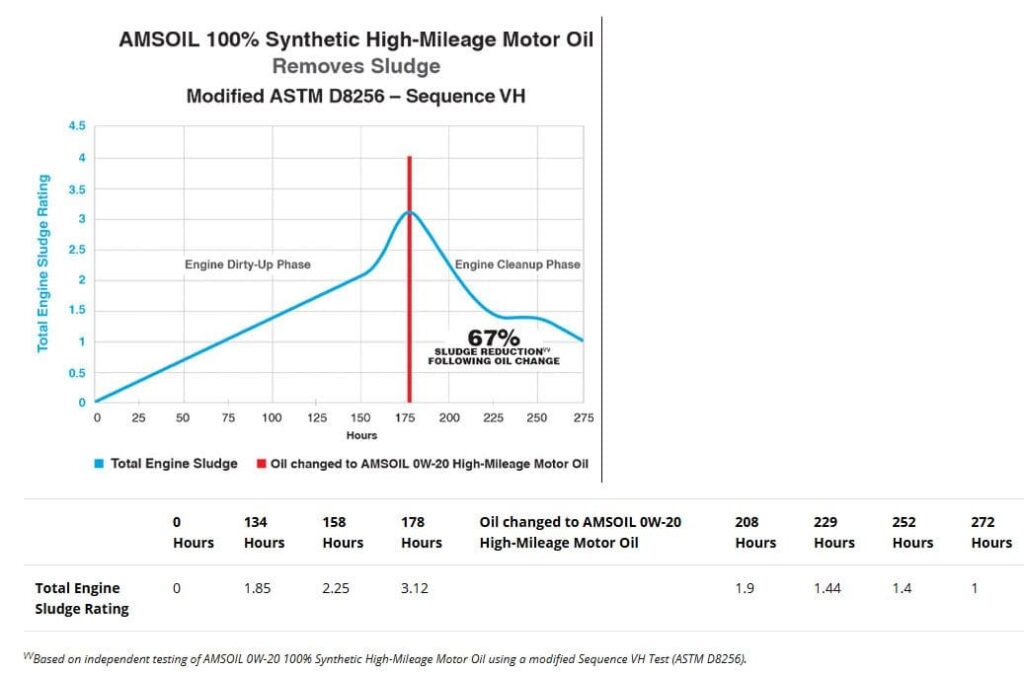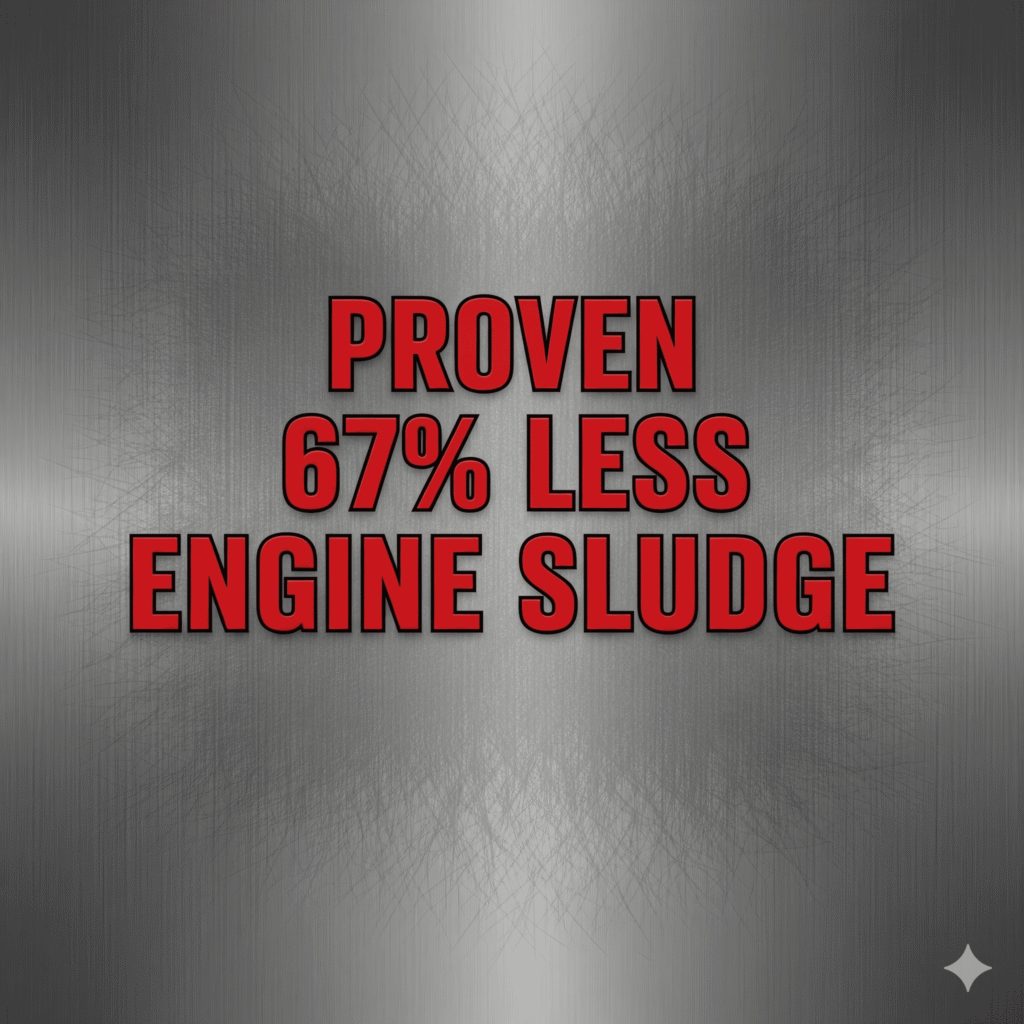Upfront Summary (for Skimmers):
- Test Standard: ASTM D8256-22a (Sequence VH) evaluates a motor oil’s ability to control sludge and varnish under moderate temperature conditions.
- Oil Tested: AMSOIL 100% Synthetic High-Mileage Motor Oil.
- Result: Achieved a 67% reduction in sludge compared to the industry standard limit.
- Implication: Demonstrates enhanced cleaning power for engines operating under stop-and-go and short-trip conditions—common in aging vehicles.
- Authority: Results reflect a modified ASTM D8256 protocol, developed and verified in industry-standard testing environments.
Section 1: Understanding the ASTM D8256-22a (Sequence VH) Test
What It Is
ASTM D8256-22a (also known as Sequence VH) is an industry-standard engine test method designed to evaluate sludge and varnish formation in gasoline engines. It simulates conditions typical of urban driving—frequent cold starts, idling, and short trips—especially relevant for high-mileage vehicles.
What It Measures
- Sludge formation in critical oil galleries and valve train components.
- Varnish deposits on piston assemblies and other hot surfaces.
- Performance relative to a reference oil over a set number of test hours using a 2012 Ford 2.0L Ecoboost engine.
Why It Matters
Excess sludge and varnish can:
- Impair oil flow
- Restrict hydraulic lifters
- Lead to oil starvation and premature wear
The Sequence VH test is widely used by engine oil formulators to validate the deposit control performance of their products under realistic stress loads.
What Does “22a” Mean?
The “22a” suffix indicates the version of the D8256 standard, updated in 2022 with possible clarifications or procedural revisions. This is common in ASTM nomenclature to ensure transparency in method evolution. For technical context, see the official standard here.
Section 2: Sludge Control Results from a Synthetic High-Mileage Oil Under ASTM D8256
One synthetic high-mileage motor oil formulation—produced by AMSOIL—was tested using a modified ASTM D8256 Sequence VH protocol. The result was a 67% reduction in sludge formation compared to the threshold set by the industry benchmark. The procedure used a 2.0L Ford EcoBoost engine under simulated short-trip, stop-and-go driving conditions.

🔍 Key Clarification:
Although the test was described as a “modified” Sequence VH, the core methodology remains aligned with the D8256 framework—focused on replicating sludge-prone driving patterns and measuring actual residue accumulation on engine components.
⚙️ Sidebar: What Ingredient Tiers Say About Sludge Control
Sludge control is fundamentally a function of chemistry—specifically, the type and amount of dispersants and detergents blended into the oil. These additives suspend soot, varnish, and oxidation byproducts, preventing them from adhering to internal surfaces under thermal stress.
In modern lubricants, additive systems generally fall into three performance tiers:
- Tier 1: Budget blends that meet minimum industry specs. Common in entry-level, mass-market oils.
- Tier 2: Mid-tier systems designed for better deposit resistance and longer change intervals.
- Tier 3: Premium systems formulated for extended drains, high-temperature stability, and exceptional cleanliness.
Most mass-market brands operate under strict cost controls. Engineers must balance performance with price by selecting ingredients that meet industry requirements at minimal cost. Independent manufacturers, however, may flip that equation—starting with a performance goal and choosing Tier 3 additives and high-purity base oils to meet it.
When an oil delivers a 67% reduction in sludge under ASTM D8256, that result likely reflects a performance-led formulation strategy—not just luck in a single test. In sludge control, what’s chosen in the lab is what ultimately shows up in the engine.
Section 3: Real-World Relevance — Why This Test Applies to High-Mileage Vehicles
Many high-mileage engines suffer from:
- Short-trip syndrome (engine never reaches full operating temperature)
- Cold weather operation
- Long drain intervals without cleaning additives
The Sequence VH test directly simulates these conditions.
So a 67% sludge reduction is not just a lab number—it reflects a practical improvement in engine cleanliness under the types of usage patterns common to aging engines:
- Less clogging of oil passages
- Better hydraulic function
- Extended engine lifespan without internal cleaning treatments
Section 4: External Validation and Industry Benchmark
The ASTM D8256-22a is maintained by the American Society for Testing and Materials, a globally recognized standards body.
Note: While the full procedural details are behind a paywall, the presence of this listing confirms:
- The methodology is official
- Widely adopted by OEMs and lubricant formulators
- Continuously updated for accuracy and reliability
Optional: Brief Appendix for Technical Readers
| Test Name | Official Designation | Purpose | Engine Used | Industry Use |
| Sequence VH | ASTM D8256-22a | Sludge + Varnish Control | Ford 2.0L Ecoboost | ILSAC GF-6 & OEM testing |
? Frequently Asked Questions
❓How does ASTM D8256 differ from older sludge tests like Sequence VG or VE?
Answer:
ASTM D8256 (Sequence VH) replaced older tests like Sequence VG and VE as the industry standard for evaluating sludge and varnish control in gasoline engines. It uses a more modern engine design (2.0L Ford Ecoboost) and reflects newer operating conditions, including tighter tolerances, higher cylinder pressures, and advanced fuel delivery systems.
Unlike its predecessors, Sequence VH puts greater emphasis on stop-and-go driving conditions—specifically cold starts, short trips, and low-load operation. These are the scenarios most associated with sludge formation in real-world engines, especially in high-mileage or poorly maintained vehicles.
❓Can sludge test results predict how long an oil will last in service?
Answer:
Not directly. ASTM D8256 measures an oil’s ability to resist sludge and varnish under a defined stress profile—but it doesn’t simulate extended drain intervals or full-spectrum degradation over time. Instead, it gives insight into how well an oil handles short-trip driving and stop-start conditions, which are common triggers for sludge formation, especially in older engines.
To understand oil longevity under real-world conditions, multiple lab tests are used—such as:
- TEOST 33C (high-temp deposit control),
- NOACK volatility (evaporation loss),
- ASTM D7528 (oxidation stability), and
- High-Temperature/High-Shear (HTHS) viscosity retention.
But even these lab methods are simulations.
The only truly scientific way to determine how long a specific oil will last in a specific engine, under specific use conditions, is through used oil analysis. By sampling and testing the oil at regular intervals, operators can monitor:
- Oxidation levels
- Viscosity changes
- Additive depletion
- Contaminants (fuel, coolant, metal wear particles)
This allows for data-backed decisions on oil change intervals and helps prevent premature wear or failure—something no lab simulation can precisely predict on its own.
Further Reading
